

Lesson Plans. Share The Great Plow Up – The Economics of the Dust Bowl Grade Level: 7–12 Related Academic Subjects: U.S.
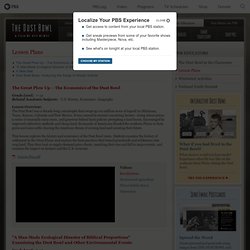
History, Economics, Geography Lesson Overview: The Dust Bowl was a decade-long catastrophe that swept up 100 million acres of topsoil in Oklahoma, Texas, Kansas, Colorado and New Mexico. This lesson explores the history and economics of the Dust Bowl years. Lesson Plan pdf "A Man-Made Ecological Disaster of Biblical Proportions" Examining the Dust Bowl and Other Environmental Events Related Academic Subjects: U.S. The Dust Bowl was an environmental catastrophe that, throughout the 1930s, destroyed the farmlands of the Great Plains, turned prairies into deserts, and unleashed a pattern of massive, deadly dust storms that for many seemed to herald the end of the world.
In this lesson, students produce their own documentary on an environmental event, either recent or in the past, in their local community. Lesson Plan pdf A New Deal Lesson Plan pdf Related Academic Subjects: U.S. Lesson Plan pdf. Overview - The Great Gatsby: Primary Sources from the Roaring Twenties - Lesson Plan. Back to Lesson Plans Lesson Overview In order to appreciate historical fiction, students need to understand the factual context and recognize how popular culture reflects the values, mores, and events of the time period.
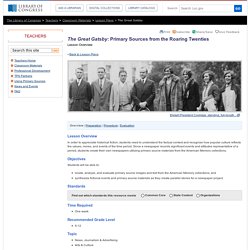
Since a newspaper records significant events and attitudes representative of a period, students create their own newspapers utilizing primary source materials from the American Memory collections. Objectives Students will be able to: locate, analyze, and evaluate primary source images and text from the American Memory collections; and synthesize fictional events and primary source materials as they create parallel stories for a newspaper project. Standards Time Required One week Recommended Grade Level Topic News, Journalism & Advertising Arts & Culture Era Progressive Era to New Era, 1900-1929 Credits Margie Rohrbach and Janie Koszoru.
Segment11-4. Welcome to OurDocuments.gov. The following is a list of 100 milestone documents, compiled by the National Archives and Records Administration, and drawn primarily from its nationwide holdings.
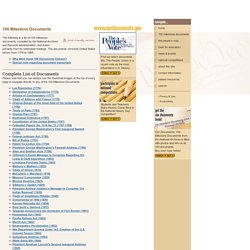
The documents chronicle United States history from 1776 to 1965. Complete List of Documents Please note that you can always use the thumbnail images at the top of every page to navigate directly to any of the 100 Milestone Documents. home 100 milestone documents the people's vote tools for educators news & events national competitions about this site contact information related resources search Privacy & Use Accessibility. Digital History. We are very sorry, but you have reached a page that has moved or no longer exists.
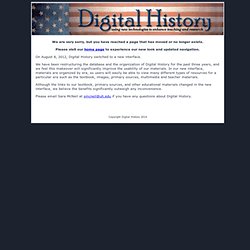
Please visit our home page to experience our new look and updated navigation. On August 8, 2012, Digital History switched to a new interface. We have been restructuring the database and the organization of Digital History for the past three years, and we feel this makeover will significantly improve the usability of our materials. In our new interface, materials are organized by era, so users will easily be able to view many different types of resources for a particular era such as the textbook, images, primary sources, multimedia and teacher materials. Although the links to our textbook, primary sources, and other educational materials changed in the new interface, we believe the benefits significantly outweigh any inconvenience. Please email Sara McNeil at smcneil@uh.edu if you have any questions about Digital History.
AAEC - Association of American Editorial Cartoonists. Tooning into history Resources to help you include political cartoons in the study of different eras Herblock's 20th Century:

The History Lab: US History Essential Questions. DocsTeach. Help your students think through primary source documents for contextual understanding and to glean information to make informed judgments.
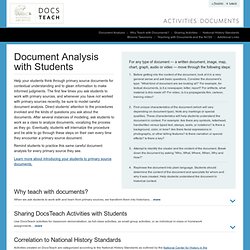
The first few times you ask students to work with primary sources, and whenever you have not worked with primary sources recently, be sure to model careful document analysis. Direct students’ attention to the procedures involved and the kinds of questions you ask about the documents. After several instances of modeling, ask students to work as a class to analyze documents, vocalizing the process as they go. Eventually, students will internalize the procedure and be able to go through these steps on their own every time they encounter a primary source document.
Remind students to practice this same careful document analysis for every primary source they see. Learn more about introducing your students to primary source documents. DocsTeach. Library of Congress Home.